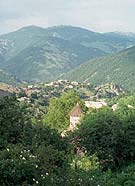|

|
Take the first
right up to Goshavank or Nor Getik Vank in the village of Gosh. The monastery was founded in 1188 by the great Armenian
cleric Mkhitar Gosh
(died 1213) with the help of Prince Ivane Zakarian as
replacement for Old Getik Vank (SW near Martuni in
Gegharkunik, on the Jivikhlu road), which was destroyed by
earthquake.
Mkhitar
is most famous for
|
|
Continuing
S of
Gosh toward Chambarak/Krasnosyelsk on a
worsening road, one reaches Khachardzan
(formerly the village of Polad), with a church W of the village.
|
UNDER
CONSTRUCTION
|
|
having
compiled a collection of Armenian laws to help his flock resist
the imposition of Muslim Shariah law.
The
monastic complex is large and well-endowed, and was for a brief
period an important center of Armenian medieval culture.
The rectangular room next to the reading room stands out
from the rest of the complex by its walls of large unworked
stones. In all probability, this room is a holdover from an
Early
Iron Age fortress built on the site perhaps 2000 years before.
The reading room itself is unusual, built in several
stages, with a chapel/bell-tower built on top in 1291. Note the intricately carved khachkar, the famous "Aseghnagorts"
("embroidered"), standing beside the S. Gregory church
doorway, the work of Master Poghos, dated 1291. Its mate was moved to the State History Museum in Yerevan.
The Gregory the Illuminator chapel is richly carved.
There is a museum in the village, along with alleged remnants of
Mkhitar's house; his tomb church stands in the village W of the
monastery.
|
|
|